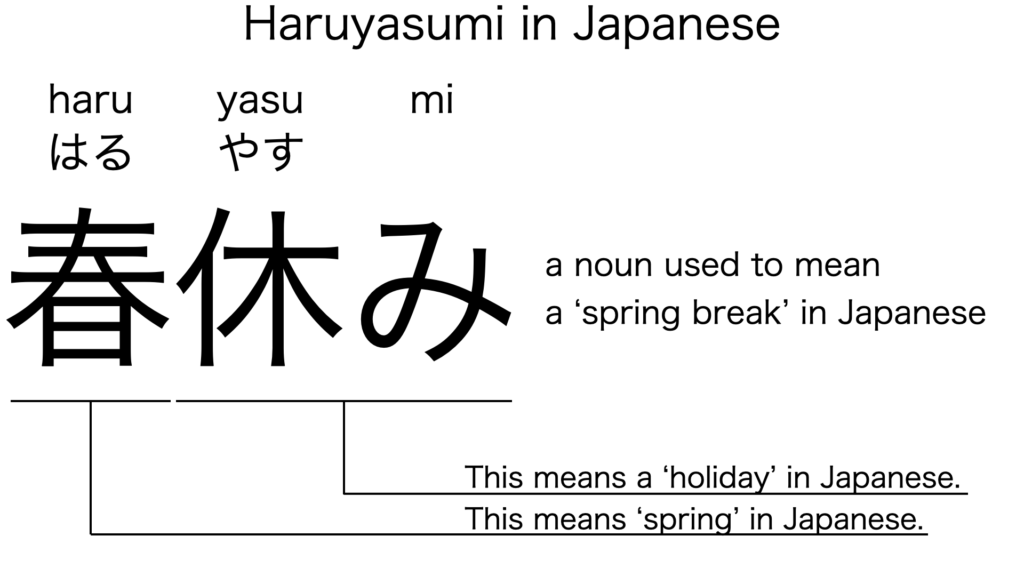What does “haruyasumi” mean in Japanese?
Native speakers use haruyasumi to mean a ‘spring break’ in Japanese. Perhaps, some Japanese learners know this word as it is sometimes used in Japanese conversations. In this blog post, however, I’m explaining this word in detail based on its kanji mixed expression. And also, I’m explaining how to use it through example sentences. My explanations would help Japanese learners understand haruyasumi more clearly. Then, let’s get started!
Contents
Definition and meanings of “haruyasumi”
Let me start with the definition and meanings of haruyasumi.
- haruyasumi – 春休み (はるやすみ) : a noun used to mean a ‘spring break’ in Japanese. This can also work as plural. Depending on the context and situation, this can also mean a ‘spring holiday’ or ‘spring vacation’ in Japanese.
The definition and meanings are simple and clear. To understand this noun more clearly, however, let me explain its kanji mixed expression in detail.
Haruyasumi in kanji
The kanji mixed expression of haruyasumi consists of the following two parts:
- haru – 春 (はる) : a noun used to mean ‘spring’ in Japanese.
- yasumi – 休み (やすみ) : a noun often used to mean a ‘holiday’ in Japanese.
From these two parts, we can understand that haruyasumi literally means a ‘spring holiday’ in Japanese. This literal interpretation is very close to the actual meanings.

When we meet new kanji expressions, we should check their kanji characters in detail to understand their meanings clearly and deeply. In many cases, kanji characters tell us a lot about the meanings of the expressions they form. Actually, here, we could get the better understanding of haruyasumi through the detailed kanji check above.
So far, I’ve explained the definition and meanings of haruyasumi together with its kanji characters. Then, let me explain how to use it through the example sentences below.
How to say “spring break” in Japanese
haruyasumi wa totemo mijikai desu – 春休みはとても短いです (はるやすみはとてもみじかいです)
Spring break is very short.
Below are the new words used in the example sentence.
- wa – は : a binding particle working as a case marker or topic marker. In the example, this works after haruyasumi to make the subject in the sentence.
- totemo – とても : an adverb of degree meaning ‘very’, ‘much’, ‘so’, or such in Japanese. In the example, this works in front of mijikai to emphasize its meaning.
- mijikai – 短い (みじかい) : an i-adjective meaning ‘short’ in Japanese.
- desu – です : an auxiliary verb used after a noun or adjective to make it polite. Probably, this is well known as a part of the Japanese desu form. In the example, this is used after mijikai to make it sound polite.
This is a typical usage of haruyasumi. In this example, it works together with wa to become the subject in the sentence.
Another example of “haruyasumi”
gakusei tachi wa haruyasumi ga suki desu – 学生達は春休みが好きです (がくせいたちははるやすみがすきです)
Students love spring break.
Below are the new words used in the example sentence.
- gakusei – 学生 (がくせい) : a noun meaning a ‘student’ in Japanese.
- tachi – 達 (たち) : a suffix used after a noun or pronoun to make its plural form. In the example, this is used after gakusei to make its plural form, gakusei tachi, which means ‘students’ in Japanese.
- ga – が : a case particle used to make the subject word or the object word in a sentence. In the example, this is used after haruyasumi to make the object in the sentence.
- suki – 好き (すき) : the stem part of the na-adjective, sukina, which means ‘favorite’ in Japanese. Native speakers, however, often use this as an individual word to mean ‘to like’ or ‘to love’ in Japanese. In the example, this is used to mean ‘to love’ in Japanese.
This is another example of haruyasumi. In this example, it works together with ga to become the object in the sentence. When we want to mean ‘spring break’ in Japanese, anyway, this noun is always a very good option.
Summary
In this blog post, I’ve explained the definition and meanings of haruyasumi in detail based on its kanji mixed expression. And also, I’ve explained how to use it through the example sentences. Let me summarize them as follows.
- haruyasumi – 春休み (はるやすみ) : a noun used to mean a ‘spring break’ in Japanese. This can also work as plural. Depending on the context and situation, this can also mean a ‘spring holiday’ or ‘spring vacation’ in Japanese.
Hope my explanations are understandable and helpful for Japanese learners.
Leave a Reply